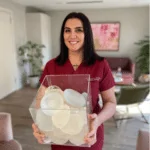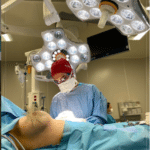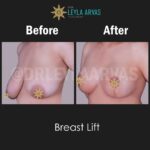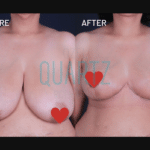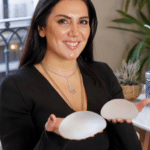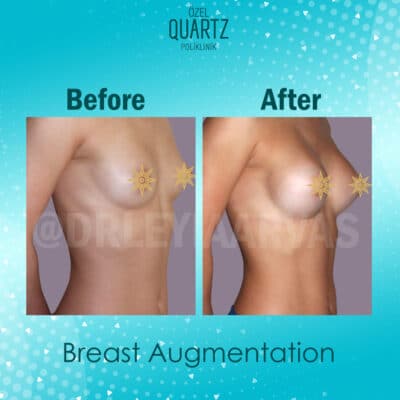 Breast augmentation is the most popular plastic surgery in the world, including in Turkey. Basically, it is applied by patients who want the desired shape and size change to their breasts.
Breast augmentation is the most popular plastic surgery in the world, including in Turkey. Basically, it is applied by patients who want the desired shape and size change to their breasts.
The operation is called breast augmentation: silicone implants of a certain shape and volume are placed in the breast area. As a result, the breast becomes fuller and toned, taking the shape that the patient wants.
How is breast augmentation surgery done?
The patient is put to sleep with the help of intravenous sedation and inhalation anesthesia. Before the operation, the surgeon marks the operating field. Then he creates access to the selected anatomical pocket and expands it to the size required for implant placement. An endoprosthesis is installed in the formed implantation zone, after which the surgical field is closed with sutures.
The set of surgical techniques and techniques used during the operation depends on the depth of installation and the type of access chosen. The operation lasts from 30 minutes to an hour, and the next day the woman returns home.
Required tests
In preparation for plastic surgery, the patient undergoes a clinical examination, which includes methods of instrumental and laboratory diagnostics. Passes tests for viral infections, if necessary, undergoes mammography. An obligatory stage of preparation for breast augmentation is ultrasonography and consultation with a Mammalogist.
Breast Anatomy
In the context of plastic surgery and augmentation mammoplasty, the emphasis should be shifted to the anatomy of the chest. The mammary glands are located superficially. They consist of an exocrine gland and well-developed subcutaneous tissue. In some, glandular tissue prevails, in others, adipose tissue is better developed. The composition of tissues changes with age, and body weight also affects it.
Immediately below the gland is the fascia – the connective tissue case of the pectoralis major muscle. Above the fascia is the first implantation zone, in which surgeons install the implant with sub glandular placement. Under the fascia, a second implantation pocket can be formed – subfascial. The third implantation pocket is located under the muscles. It is used for axillary or submuscular implant placement.
Types of implants
Previously, saline implants, which are a silicone capsule filled with saline, were used for breast augmentation. Today they are rarely installed, and in the best clinics, saline implants have been completely abandoned. They were replaced by implants filled with silicone polymer. They have shape memory and are highly durable. Manufacturers (Arion, Mentor, Polytech) provide products with a lifetime warranty.
Silicone implants differ in shape, height, width of the lower segment and other characteristics. Anatomical implants are teardrop-shaped with an enlarged lower pole. Round implants have the shape of a regular hemisphere. The width of the base is another important parameter that allows you to model the contours of the chest and reduce the severity of the chest gap (the distance between the mammary glands). The profile of the implant affects the visual perception of the breast. With equal volume, high profile implants give the effect of greater bust enlargement.
Selection of implants
When choosing an implant, it is necessary to take into account many features of the figure. The size of the breast, the development of subcutaneous tissue, the width of the chest, the distance between the glands, the age and body weight of the patient matter. With an initially large distance between the glands, it is better to install anatomical implants with a wide base. If a woman wants to fill the décolleté area, she should opt for round implants.
The choice of implant volume should be approached carefully. It is undesirable for middle-aged women with initial signs of a decrease in skin elasticity to increase their breasts by 1.5-2 sizes, since heavy implants can accelerate the development of Masto ptosis. A radical increase in the bust is not recommended for thin girls.
It is important to understand that the main goal of the operation is to improve the aesthetics of the breast for many years, and for this it is necessary to take into account a lot of factors. Computer simulation gives an idea of the short-term result. The aesthetic result of the operation, which will delight a woman for many years, is achieved only thanks to the rich experience of a plastic surgeon, multiplied by high qualifications.
Implant placement options
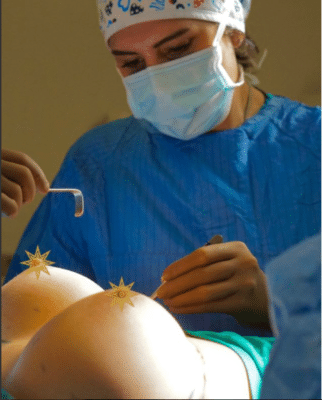 The factor that determines the aesthetic value of mammoplasty in the short and long term is the choice of the implant pocket. We remind you that the main task is to improve the aesthetics of the breast for many years, and the depth of the implant should be consistent with this goal.
The factor that determines the aesthetic value of mammoplasty in the short and long term is the choice of the implant pocket. We remind you that the main task is to improve the aesthetics of the breast for many years, and the depth of the implant should be consistent with this goal.
It is possible to install an implant under the gland only with good development of subcutaneous adipose tissue. Slender girls are shown an axillary or subfascial installation. A mixed option is often used – placement in two planes, in which the upper segment of the implant is under the muscle, and the lower third is covered by the gland.
It is the combined arrangement that is recognized as optimal. With this placement, the load on the ligamentous apparatus is reduced and the manifestations of age-related Masto ptosis in the long term are reduced. Minimizes the risk of capsular contracture. When probing or “by eye” it is impossible to determine the implant.
Access for breast implants
Three types of access are used to install implants: around the areola, in the fold under the gland, and in the axillary fossa. Consider the advantages and disadvantages of each method.
With a peri areolar approach, the incisions pass around the areolas. The installation is performed through the gland, and therefore there is a risk of damaging its ducts. This type of access is not indicated for women who plan to give birth and breastfeed a baby. The advantage of the peri areolar method is that the scar runs along the perimeter of the pigmented area and is practically invisible.
With sub mammary access, skin incisions are made in the fold under the mammary gland. During the operation, the gland is not affected. There is no risk of damaging the milk ducts, but you can touch the nerve that is responsible for the sensitivity of the nipple and areola. The scar is hidden under the gland. Advantage: the ability to increase the breast by 2 sizes (or more) and install implants in any of the anatomical pockets.
With axillary access, the scars are hidden in the armpit and do not affect the aesthetics of the bust. The implant is placed in the axillary pocket, which allows you to get a stable aesthetic result. The operation is performed under the control of endoscopic equipment. Tissue injury is minimal, recovery is fast.
When choosing an access, the surgeon takes into account the individual characteristics of the patient.
Each method has limitations, and which one will be optimal in a particular case depends on individual characteristics. Operation with trans axillary access is somewhat more expensive due to the greater complexity of the intervention.
Indications for augmentation mammoplasty
Each patient of a plastic surgeon has her own reasons and motives, wishes and hopes. One thing unites them – they decided to change their lives for the better. Become younger, prettier, sexier. Breast augmentation and correction of imperfections in appearance, acquired or bestowed by nature, is not carried out for medical reasons. The indications are aesthetic, and the main among them is the desire of a woman to reveal and increase beauty, while maintaining a bright individuality.
Aesthetic indications for surgery can be divided into several categories.
- Naturally small breasts, size zero or 0.5. The next group of indications is breast asymmetry, causing physical or psychological discomfort. The objective degree of asymmetry does not matter, everything is determined by the subjective feelings of a woman.
- Deterioration of breast aesthetics can be caused by postpartum involution. An increase in the mammary glands during lactation with a subsequent decrease in volume leads to the appearance of stretch marks and sagging of the bust. No one wants to put up with such shortcomings in appearance at a young age, and breast augmentation offers a ready-made solution to this problem.
- The problem of age-related involution of the breast, caused by a reduction in the volume of glandular tissue, is also solved with the help of augmentation, or mammoplasty. If there are signs of Masto ptosis, mastopexy is performed simultaneously with the installation of implants.
Indications for breast augmentation
- Dissatisfaction with the size and shape of their own mammary glands.
- Tubular or too small breasts.
- Severe asymmetry: difference in size or location of the nipple.
- Loss of volume after losing weight, due to age or injury.
- The need for reconstruction after a mastectomy.
As a rule, there are no medical indications for plastic surgery. All the reasons why patients turn to plastic surgery are aesthetic and related to the desire to improve the perception of their own body.
Contraindications for surgery
- Oncological diseases in the active phase, out of remission.
- Severe diseases of internal organs in the stage of decompensation.
- Uncompensated diabetes mellitus.
- Blood clotting disorders.
- Severe cardiovascular and respiratory disorders.
- Acute conditions or exacerbations of chronic diseases.
- active inflammatory processes.
- Psychical deviations.
- Age up to 18 years.
- Pregnancy and lactation.
In some cases, the operation is performed with caution – for example, in the presence of breast diseases. In such situations, we recommend that you come to a free preliminary consultation with a plastic surgeon in order to discuss the possibility of an intervention with the doctor.
How is breast augmentation performed?
- Training. At a preliminary consultation, the doctor and the patient together determine what the intervention and the implant will be. After that, as part of the preparation, you will need to take blood and urine tests, as well as an ultrasound of the mammary glands. Mammography is also shown to patients after 40 years of age.
- Anesthesia. The operation is performed under general anesthesia, therefore, before it is carried out, it is necessary to consult an anesthesiologist. He will collect an anamnesis, clarify the absence of contraindications, and, if necessary, prescribe additional examinations. He will select the option of anesthesia, which will be as safe as possible for the patient. With contraindications to any anesthesia, the operation is not performed.
- Operation. The doctor will make an incision in the desired area, form a special capsule and carefully place breast implants, giving the breast the desired shape. If the intervention is complex, correction, lifting or nipple plastic surgery is carried out at the same stage. After completing the manipulations, the surgeon applies sutures and a sterile bandage to the incisions. The patient is dressed in a special compression underwear and transferred to the recovery room.
- Recovery. The first day the patient is in the hospital under the supervision of doctors, after which she is allowed to go home. Bed rest is not necessary, but in the early days you will need to refrain from sudden movements with your hands – this can move the implant. In the following weeks, you will need to observe restrictions on physical activity, sleep only on your back, and refrain from visiting the sauna and solarium. The doctor will tell you more about the restrictions, he will also issue a memo on behavior after arthroplasty.
Rehabilitation after Breast Augmentation
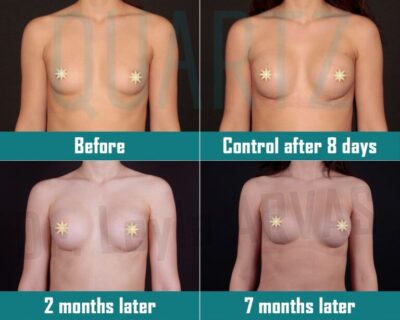 Discipline and responsibility are the main requirements for a woman during the recovery period after breast augmentation. It is extremely important to follow all the recommendations of the surgeon, especially those related to wearing compression garments and physical activity.
Discipline and responsibility are the main requirements for a woman during the recovery period after breast augmentation. It is extremely important to follow all the recommendations of the surgeon, especially those related to wearing compression garments and physical activity.
Compression garments should be worn constantly, day and night, for 4 weeks. The doctor can reduce or increase this period, but you cannot “cancel” the compression on your own. This simple measure speeds up healing, helps to fix the new shape of the bust and fix the implant. Reduces swelling and pain.
Pros and cons of breast surgery
The operation instantly transforms the appearance of the breasts and the figure of a woman. The result is immediately visible, and changes for the better become more and more evident as the tissue heals. With the help of plastic surgery, you can increase the breasts by several sizes at once and eliminate the asymmetry. It is possible to change the shape of the bust and correct aesthetic defects, both congenital and developed as a result of age-related or postnatal changes.
The only disadvantage of breast augmentation with implants is that the operation does not stop the aging process of the body. Over the years, the volume of natural tissues decreases, which changes the shape and size of the breast. As a result of a decrease in skin turgor, signs of mast ptosis appear. Implantation does not provide immunity against these changes, but this is beyond the power of all modern science.
You can not expose yourself to physical exertion: it is forbidden to lift heavy objects, do aerobics, swim, go to the gym, dance or yoga studio. A strict ban on physical activity is valid for about a month, and all restrictions are lifted after three months. During this time, you should not sunbathe – ultraviolet rays increase the pigmentation of postoperative scars.
Theoretical Complications of Breast Augmentation
Strict adherence to the rules of the rehabilitation period is the best prevention of rare complications of breast augmentation. Complications such as displacement or rotation of the implant, in 99.9% of cases, are associated with a violation of the motor regimen during the rehabilitation period. Capsular contracture, the appearance of “waves” or “ripples” on the skin can also be the result of neglecting the recommendations of a plastic surgeon.
How long does the breast heal after plastic surgery?
Breast augmentation is the most popular procedure in cosmetic surgery, the methods of which are constantly being improved so that women after plastic surgery can resume their daily life in the shortest possible time . It is important to understand that the recovery period is a relatively short but important step in achieving the most favorable results.
Mammoplasty is usually performed on an outpatient basis under general anesthesia , although in some cases the operation may be performed with local anesthesia. Patients can usually go home after the procedure. Breast augmentation is often combined with surgeries such as breast lift, abdominoplasty (tummy tuck), liposuction, lipolysis.
Factors Affecting Recovery Time
Rehabilitation after mammoplasty depends on a number of factors, including:
- breast tissue density,
- implant size,
- implant placement,
- surgical technique.
It is important to understand that the amount of time it takes to recover from breast augmentation varies greatly depending on the individual.
Breast implants are available in a wide range of sizes. The size of the implant may have an impact on the recovery time. For example, large implants put more pressure on the pectoral muscle, and can cause stretching of the overlying skin. This can lead to the fact that rehabilitation after breast augmentation will take a little longer.
Breast implants are placed either above or below the pectoral muscle, according to the patient’s lifestyle and aesthetic goals. Axillary (submuscular) placement is more invasive because, in addition to requiring a skin incision, this technique requires the separation of a portion of the pectoral muscle to make room for the implant. This placement option is often recommended for women who desire the most natural looking results and who do not regularly engage in activities that require significant upper body effort.
When breast augmentation involves placing implants under a muscle, the muscles can “trap” the implant and keep it in a high position. Lowering the implant can take two to three months or more.
The recovery time after breast augmentation is shorter with the sub glandular technique (under the mammary gland), compared to submuscular breast augmentation. Discomfort in the first case lasts about 4 days, and in the latter – 10-12 days.
As in the rehabilitation period after any operation, recovery after mammoplasty will take time. To better prepare patients for their recovery time, below is information on what to expect in the coming weeks and months after surgery. Patients should carefully follow all postoperative instructions to minimize discomfort and speed up the healing process.
Recommendations for recovery
Each plastic surgeon has their own recommendations for recovery after mammoplasty, but in general, rehabilitation after breast augmentation includes the following steps:
- discontinuation of pain medications : 1-2 days;
- return to work: 3 days;
- light exercise: 2-3 weeks;
- Scar maturation: 12 months.
First weeks after surgery
- During the first 24 hours there is a risk of early bleeding . Ice packs can be used during this time to reduce swelling, and any type of heat in the chest area should also be avoided.
- The first 4 days are an inflammatory period, which is characterized by swelling, pain, discomfort. During this period, the vast majority of drugs are used and regular monitoring of body temperature is necessary.
- A normal consequence of breast augmentation is a feeling of tightness in the breast area as the skin adjusts to the new size of the breast and breast implants.
- For the first two to three days after surgery, patients should wear a compression garment or a special surgical bra over dressings. After the dressings are removed, a surgical bra must be worn for the next few weeks.
- From days 4 to 10, you can take a shower if allowed by the surgeon, after which it is necessary to dry the wounds and dressings thoroughly (use a hairdryer). At this time, you can not wash your hair yourself, because it is forbidden to raise your hands above your head.
- Constipation is possible due to a side effect of pain medications. Pain tends to decrease throughout the day with less need for medication. However, the pain is usually observed at night between 3 and 6 o’clock. The pain is worse when implants are placed under the muscle.
- In the period from 7 to 10 days, bleeding or infection is possible. Bruising and swelling are normal after surgery and usually subside within a few weeks.
- Patients are advised to avoid any heavy work or strenuous exercise for several weeks after surgery. The use of the lever for everyday activities, that is, such movements as are required when brushing teeth, eating, combing hair, should be limited.
- Within two weeks of plastic surgery, it is important to stop using any medications or supplements that may cause bleeding, including fish oil , herbal supplements, and aspirin.
- While sleeping, place at least two or three soft pillows under your upper back and head to keep your torso elevated. This helps relieve pressure on the treatment area, reducing swelling and pain. You can’t sleep on your stomach.
- Patients should avoid driving until they are no longer in pain from the seat belt, which can take several weeks.
- On days 10 to 21, there is a decrease in the risk of infection and bleeding. It is possible to increase physical activity, perform simple exercises designed for the lower body. The vast majority of edema begins to subside. Sometimes there is pain at night. The nerves begin to wake up, which can lead to tingling sensations in the nipple area.
First few months after surgery
During the 4-6 weeks of the rehabilitation period, wound healing occurs at a constant rate. Painkillers are rarely required. You can begin the transition from low-activity activities to aerobic exercise. Any contact with the breast should be gentle for four to six weeks.
Changes in the sensation of the skin of the breast and nipples are common side effects after plastic surgery. Numbness of the breasts and nipples may be felt by some women up to a year after breast reduction surgery, while others may experience hypersensitivity in the breast area. It is important to keep in mind that in some cases these altered sensations may become permanent.
Some surgeons recommend wearing a well-fitting sports bra 24 hours a day for up to three months after surgery. An underwire (or push-up) bra can be worn for at least 6 weeks until the wounds have properly healed and the breast implants are in a permanent position.
- For 6 weeks, you must sleep on your back, sleeping on your stomach or side is prohibited.
- Breast massage can facilitate correct positioning of breast implants and prevent capsular contracture.
- Patients should be aware that their breasts may swell and become firm during the first postoperative period. In addition, some women may experience sporadic pain for several months, especially during menstruation. Your doctor may prescribe pain medication to relieve these symptoms and reduce discomfort during the recovery period.
- Up to 9 months there is a progressive relaxation of scar tissue and resolution of the remaining 5-10% swelling. The chest as a whole becomes softer. During this time, most patients accept implants as part of their body.
- Although the breast becomes stable in its new shape, it is important to understand that the shape of the mammary glands can fluctuate in response to hormonal changes, weight changes, pregnancy, and the onset of menopause.
- During the year it is necessary to protect the incisions from direct sunlight and refrain from visiting the solarium, because the skin in these areas is thinner.
Complications after breast augmentation
Soreness and pain
After breast augmentation, patients may experience some painful attacks or general discomfort. These symptoms sometimes persist for several weeks.
Probably the most important factor in improving the ability of patients to recover from surgery is the elimination of pain. Adequate pain control is considered by some surgeons to be very important in the early rehabilitation period. Individual pain thresholds vary greatly. Women who have had children tend to experience less postoperative pain as they have a much higher pain threshold. Some patients compare pain during recovery to that experienced during breastfeeding.
Surgeons recommend that patients take prescribed pain relievers regularly every 4 to 6 hours, especially during the first 24 to 48 hours. Patients usually take pain medications (ibuprofen, paracetamol, Tylenol) for 1-2 days. Patients should not take ibuprofen if they have stomach, kidney or liver problems, or if they have had them in the past.
Edema
Edema is a normal postoperative consequence. Usually swelling and puffiness disappear within 2-3 weeks. Since the breast tissue is significantly disturbed during the operation, swelling may persist for up to 3-4 months, although it may be very small, noticeable only to the patient. The final size and appearance of the breasts can be assessed after 3 months, when 90% of the swelling has resolved and the breasts are soft.
Treatment for prolonged edema includes increasing fluid intake (preferably water), decreasing sodium intake, and physical movement such as walking.
Scars
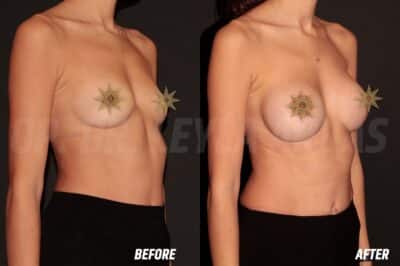 While breast augmentation scars are permanent, in most cases they will fade and improve significantly over time. Plastic surgeons go to great lengths to hide and minimize stitches and scars.
While breast augmentation scars are permanent, in most cases they will fade and improve significantly over time. Plastic surgeons go to great lengths to hide and minimize stitches and scars.
To place the implants, the surgeon makes an incision in one of the following areas: on the underside of the breast in the sub mammary fold (inframammary incision); under the arm (axillary incision); around the nipple (peri areolar incision).
The inframammary incision creates an inconspicuous scar under the breast. Peri areolar incision is made exclusively along the border of the areola. A peri areolar incision can cause problems with changes in nipple sensation, but the scars are usually barely noticeable. In the case of simultaneous abdominoplasty, a transabdominal incision is used (on the skin of the abdomen in the bikini area).
When reduction mammoplasty is performed, rather large incisions are used. The surgeon may hide some incision lines in the natural contours of the breast, but others will be visible on the surface of the breast. Fortunately, incisions can usually be limited to areas of the breast that can be covered by a bra.
Patients should follow all postoperative instructions and monitor the condition of the sutures to control infection. Caring for your incisions can help reduce the appearance of scars and speed up healing time. The stitches are removed after about ten days.
Smoking dramatically slows down the healing process and can lead to serious complications. Nicotine causes blood vessels to constrict, inhibits the function of red blood cells, and reduces the level of oxygen in the blood. Cells must divide and grow in order to heal wounds, and without sufficient oxygen, this process can be significantly delayed. Nicotine can also greatly increase the risk of infection.
Scars may be swollen and red for several months. Scars usually begin to fade and soften after 3-6 months. The final result can be seen in a year. In practice, in 3-6 months, the scars will be very close to the final result, in the form of thin white lines, becoming less noticeable.
Breast Augmentation Cost in Turkey
How much breast augmentation costs in Turkey does not depend on the time spent by the doctor, on the number of consumables or medicines, as well as on subsequent examinations and the size of the implant. All that matters in pricing is the type of access, the type and presence of the implant. In some cases, prices may differ – this happens if the patient has chosen a complex surgery. For example, the installation of an implant occurs simultaneously with a breast lift or correction of the shape of the nipples.
Plastic surgeon’s consultation : Free
What is included in the cost of breast augmentation?
Consultations of a plastic surgeon and an anesthesiologist.
The initial appointment is free, all other meetings with doctors are already included in the price of breast augmentation. However, you need to pay extra for the examinations separately – this can be done in our clinic or in third-party institutions.
The cost of the implant. We use Polytech, Mentor, MOTIVA and other silicone implants. Models are presented in two forms and various smoothness options. They can also differ in the level of softness, tactile sensations, volume – all these parameters do not affect the price, only the shape and brand matter. Which option to choose, the patient decides together with the plastic surgeon.
General anesthesia and preparation for it. The price tag does not include only the tests that must be taken before the operation – the tests can be carried out on the basis of our clinic or separately.
Carrying out the operation. The work of the surgeon, consumables – all this is already included in the price indicated on the site.
Hospital stay. During the day after implantation, the patient remains under the supervision of doctors in the hospital “Bustcliniki”. Meals, postoperative care and the ward are already included in the price.
Compression garment. For several weeks after the operation, you will need to wear special underwear, which will be given out and helped to put on in the hospital.
Postoperative care. Doctor’s consultations and dressings are also included in the price of a turnkey intervention.
What is not included in breast augmentation?
Analyzes and research. Before the operation, the patient must undergo a series of examinations that will confirm that she has no contraindications to anesthesia. Their price is not included in the cost of the operation, however, you are not required to undergo examinations on the basis of the quartz Clinique. This can be done in any other medical facility or laboratory.
Consultations of additional doctors. In some cases, patients require consultations of other specialists, in addition to the surgeon and anesthesiologist. It can be a therapist, Mammalogist or oncologist. Their assistance is not included in the cost of the operation at the Bustclinic: you can go to any other clinic for an examination and consultation.
What is the difference between breast surgery options?
Regardless of the chosen form of intervention, you will receive first-class care, and the operation will be carried out on a turnkey basis. However, the cost varies depending on which access method and shape of the implant you choose together with your doctor.
The shape of the implant. There are two main options:
Round. The breast with such an implant looks taut, with a push-up effect, even without a bra. The implant itself is a hemisphere, and its size does not affect the cost.
Anatomical. Such an implant provides a natural appearance and looks like a teardrop – it repeats the natural outlines of the breast. After the installation of anatomical implants, the mammary gland looks natural.
Both types are available in different sizes and textures, are made from safe materials and feel like real breasts – they are filled with medical grade silicone gel. But the operation using a drop-shaped implant is somewhat more expensive. This is due to the higher price of the implant itself, as well as the greater complexity of the operation.
Advantages of contacting us
- Quartz Clinique in Istanbul doctors who specialize in this type of surgery work. They have vast experience and a rich portfolio, which minimizes the risk of unpredictable results.
- Due to the profile specialization, the clinic is equipped with top-end equipment and has agreements with trusted suppliers of implants, medicines and consumables.
- The clinic has been operating since 2015 and during this time has dealt with more than 5 thousand patients. Their reviews can be found on the respective pages.
- We have fully calculated the cost of the intervention for you and included the maximum possible number of points in it. You do not have to pay extra for something separately, the service is provided on a turnkey basis.
- The initial consultation by appointment is free. You can consult a doctor in person or via video call if you are in another city or cannot visit the clinic for some reason.
- If you want to increase your breasts, start by consulting a doctor first. Leave a request on the website or contact our assistant by phone: a free initial appointment will help you navigate the breast augmentation cost and options.

